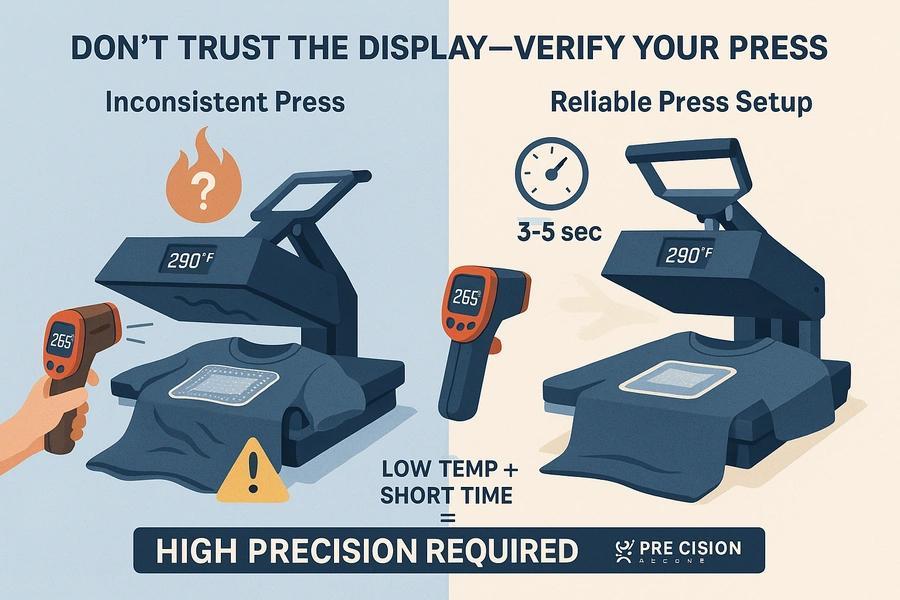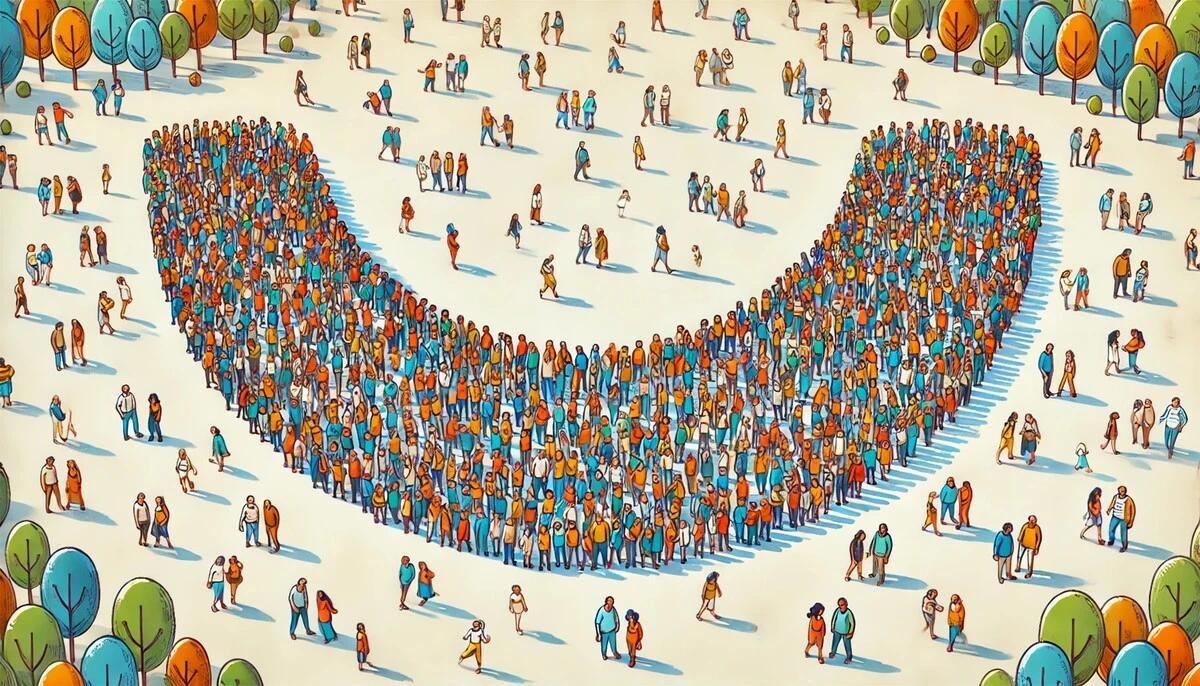Heat Pressing the DTF Transfer: Precision and Reliability Matter
You’ve got high-quality transfers—don’t sabotage them with an unreliable press. This guide covers what makes a good heat press, how to verify your temps and pressure, and why consistent equipment matters when you're using short dwell times and low heat.

Before You Continue...
Our DTF transfers are calibrated for precision workflows—specifically low temperature and short dwell times (around 290°F for 3–5 seconds). That’s how we preserve color, vibrancy, and hand feel.
But if:
- You’re not using a verified, reliable heat press
- You skip the pre‑press stage
Then you’ll need to increase your press time to compensate. That means 6–10 seconds, and no more than 12 seconds to avoid scorching or dulling colors.
This isn’t a scare tactic—it’s a practical tradeoff. Longer press times can still give acceptable adhesion, but they may sacrifice feel and finish. Do what fits your workflow and budget, but know that short, dialed-in presses are the pro way to get repeatable, premium results.
The Main Press: Where It All Comes Together
The Main Press: Where It All Comes Together
If you’ve done a proper pre‑press (and if not, seriously—go check this out), you’re ready for the main stage: pressing the DTF transfer onto the garment.
With our calibrated film, adhesive, and ink system, this step is fast: 290°F for 3–5 seconds. But that only works if your press setup is rock solid.
What Makes a Good Heat Press?
We’re not here to pitch brands, but if you care about quality, your press needs to be:
- Flat and even – consistent pressure across the platen
- Thermally stable – minimal temperature drift or hot/cold spots
- Rigid – no flexing or loose mechanical parts
- Accurate on time and temp – especially when working in seconds, not minutes
If your press is sagging at the corners or drifting 20°F from what the display says, you’re flying blind—and short press cycles leave no room for error.
Don’t Trust the Display—Verify It
Your press’s built-in display reads the thermocouple, not the surface. And thermocouples can lie.
Pick up a thermal temperature gun (they’re $20–$40 on Amazon) and test your press:
- Heat it to your target (e.g., 290°F)
- Scan the center, corners, and midpoints of the upper platen
- Look for variations. A 10°F+ drop at the edge can ruin adhesion
Knowing your heat distribution lets you adjust your positioning—or better yet, address the issue before a customer complains.
Pressure: The Often Overlooked Variable
Heat is half the story. Without reliable pressure, your transfer won’t bond cleanly.
- Manual presses need firm, even closure with a consistent clamping force.
- Pneumatic presses offer repeatable pressure settings and are ideal for production—but not required.
If you’re getting inconsistent results across garments, pressure variation is often the culprit.
Your Equipment Reflects Your Quality
If you’re using DMandprints transfers, you’re clearly not skimping on materials. But if your heat press isn’t reliable, it undermines everything.
A quality press doesn’t have to be top-of-the-line—but it must be trustworthy. That means:
- Even heat
- Consistent pressure
- Repeatable performance
That’s what gives you perfect adhesion, clean edges, and long-lasting prints with excellent color and feel.
Bottom Line
Short dwell + low temp = precision required. You can’t afford guesswork.
Invest in a thermal temp gun, understand your press’s quirks, and validate your process. That’s how you ensure every press delivers pro results—and your customers keep coming back.
What People Are Saying
FIVE STARS!
"With Dmandprints, I’ve increased my business by over 30%, while saving both time and money. Their quality, service, and attention to detail have been outstanding—highly recommended!"

Essential Tips for Quality DTF Printing
Our guides are perfect for both beginners and seasoned print professionals. Discover valuable tips for creating artwork, mastering heat press techniques, and more. These resources ensure you achieve the best quality final product.
What Makes Dmandprints Different
Loading...
Popular Guides
Loading...
Creating Images for DTFs
Loading...
Feature Articles
Loading...
Q & A
Common Questions
Here are some quick questions and answers we frequently get about DTF prints and DMandPrints. We've placed them right here on the home page for your convenience!
Do you really think you have the best prints in the world?!
Do you really think you have the best prints in the world?!
Mmm... we think they’re pretty great—and we work relentlessly to keep making them better. It’s a bold claim (maybe even a little cocky), so we’ll let the results speak for themselves.
Do you sell printed garments?
Do you sell printed garments?
No, we only sell the prints.
You can purchase your own garment and a heat press to apply the heat transfer prints to your own garments. Our customers are typically small, medium and large screen printers that want to offer heat transfers as an alternative to their standard screen printing process.
Is Gang Sheeting Necessary for Your Artwork?
Is Gang Sheeting Necessary for Your Artwork?
There is no need to gang sheet your artwork.
We charge only for the actual print area. Our image processing system automatically removes any unnecessary transparent space around your image to accurately calculate the print area for our per-square-inch pricing.
Gang sheeting not only costs you time but can also cost you money. We can only trim transparent space around the edges of your artwork. If you create a gang sheet yourself, you might introduce unprinted space that increases the total square inches, leading to higher costs.
Summary
The easiest and most cost-effective way to get your prints is to simply upload your artwork. We'll handle the gang sheeting for you, saving you both time and money.
Are DTF prints better than traditional screen printing?
Are DTF prints better than traditional screen printing?
It's not a matter of being better or worse; DTF (Direct to Film) printing is simply an alternative to traditional screen printing. Both methods have their own unique advantages.
DTF heat transfers feel similar to screen-printed shirts and can often be more durable. Additionally, DTF printing allows for unlimited colors in a single print, providing flexibility for intricate and colorful designs. On the other hand, screen printing is well-loved for its ability to produce vibrant, long-lasting prints, especially in bulk.
Choosing between the two methods depends on your specific needs and preferences.
What types of fabrics can DTF prints be applied to?
What types of fabrics can DTF prints be applied to?
DTF prints can be applied to a variety of fabrics, including cotton, polyester, blends, leather, and even some non-textile materials.
Are DTF prints durable?
Are DTF prints durable?
Yes, DTF prints are known for their durability and can withstand multiple washes without fading or peeling.
Do DTF prints feel heavy or stiff?
Do DTF prints feel heavy or stiff?
No, DTF prints have a soft feel and do not add significant weight or stiffness to the fabric.
Can DTF prints be used for detailed and colorful designs?
Can DTF prints be used for detailed and colorful designs?
Yes, DTF prints are excellent for detailed and colorful designs, providing vibrant and high-resolution results.
Is DTF printing cost-effective for small batches?
Is DTF printing cost-effective for small batches?
Yes, DTF printing is cost-effective for both small and large batches, making it ideal for custom and limited-run designs.
Can I create DTF prints at home?
Can I create DTF prints at home?
While it's possible with the right equipment, most people prefer to use professional services for higher quality and ease of use.